Buthrotum (Butrint)
Q188694Buthrotum (Greek: Βουθρωτόν): port in western Epirus, modern Butrint.
A Port on the Epirote Shore
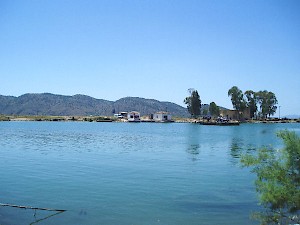
The ruins of Buthrotum are situated about two kilometer from the eastern shore of the strait that separates Corcyra from the mainland. Directly east of Buthrotum is ancient Lake Palodes, full of mussels and fish and connected to the Strait of Corcyra by what is now called the Vivari Channel. Buthrotum is situated on the northern bank of this water course, at the place where it leaves Lake Palodes.
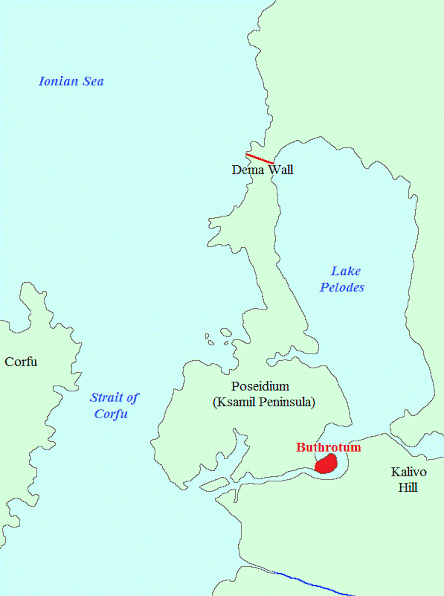
The five‑kilometer-long peninsula that stretches north of the town used to be called Poseidium,note and touches the mainland at a place called Dema. Dema and Buthrotum mark the northernmost and southeasternmost part of the peninsula. Its southwesternmost point is Cape Scala, where the Strait of Corcyra is narrowest.
Origins
The site was already occupied by fishermen in the Late Bronze Age, and must have remained a small hamlet during the Dark Age. At end of these poorly understand centuries, the area belonged to the Chaonians, one of the three tribes of Epirus. (The other two were the Molossians in the east and Thesprotians in the south.) In the mid-seventh century, Greek settlers founded Buthrotum, building a small fort (¾ hectares) on a hilltop.
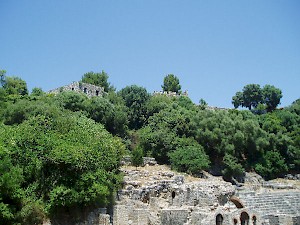
The first inhabitants must have arrived from nearby Corcyra (Corfu), which may have been founded a century before. It is likely that the Corcyrans occupied the place for both strategic and commercial reasons: it gave them better control of the strait, could be utilized as a fishery, and could serve as port of trade, where they could exchange products with the Chaonians. Most ceramics are from Corcyra, but sherds from Corinth, Attica, Chios, and Samos have also been excavated.
Of course, these beginnings were too modest to satisfy later generations, and younger legends, to which we will return in a moment, gave the town roots in ancient Troy, an idea for which the ancients invented the usual far-fetched etymologies. A more plausible, modern theory is that "Buthrotum" is derived from an Illyrian word that is rendered as bouthos in Greek and is related to modern Albanian buzë, "shore".
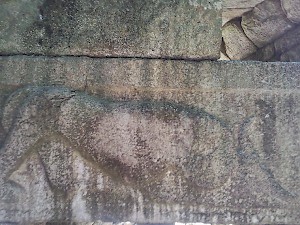
Little is known about this early period. There must have been a monumental temple; an archaic frieze, showing a lion devouring the head of a cow or bull, has been reused as lintel in the Lion Gate. Buthrotum must have been a town of some size and importance, because it is mentioned in Hecataeus' description of the European shores.note
It is said that in this age, the Chaones were the most important tribe of Epirus.note We do not know whether they controlled Buthrotum; if they did, it is possible that soldiers from the town fought against the Corcyrans and Athenians in the first years of the Archidamian War, in the battle of Stratus (429).note During the fights, the Chaonians lost so many men that their political power in Epirus was broken. From now on, the Molossians were the most dominant tribe.
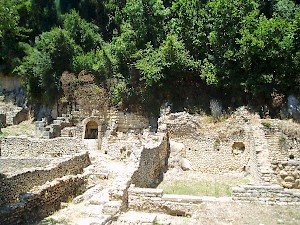
At about the same time, the Dema Wall was built. We do not know against whom. If Buthrotum was in Greek hands, the Corcyrans may have found it useful to protect the peninsula against Molossian attackers; if it was a Chaonian town, the wall may have protected the town against Corcyran attacks.
The Trojan Connection
In the first quarter of the fourth century, king Alcetas of Molossis, supported by Dionysius I of Syracuse, united Epirus and conquered the ports. Whatever the position of Buthrotum as town within Chaonia, it was now certainly under Epirote control. In c.380, the town was surrounded by a new wall, which enclosed about four hectares. The ancient fort remained in use as acropolis.
The Molossians were a comparative newcomer, who needed a decent founding legend to become a respectable power in the Greek world. The Molossians had already created something: they claimed that their kings were descendants of Achilles' son Neoptolemus and Andromache, the captive widow of the Trojan prince Hector. The Athenian playwright Euripides had already used this subject matter in one of his tragedies, the Andromache.
The acquisition of Buthrotum offered another opportunity to propagate this idea. Many places in the neighborhood of the town fitted in the Trojan legend: one of the gates was called the Scaean Gate (like the main gate in Troy), the name was supposedly derived from Greek bous, after a cow that the Trojan prince Helenus had been following, a river was named after the Simoeis, the name of the nearby port Onchesmus, modern Saranda, was derived from Anchises, a Trojan hero.
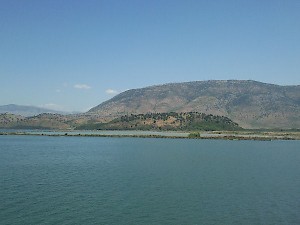
The direct cause of this myth-making may have the presence of some old ruins on a hill near Buthrotum, which may in Illyrian well have been called something like troje, the modern Albanian word for "ruins". However that may be, stories about Buthrotum's Trojan past can be found in several ancient authors, like Dionysius of Halicarnassus,note, Virgil,note and Stephanus of Byzantium.note


